Assessment Item 2: Cloud Computing Models and Data Centre Solutions
VerifiedAdded on 2020/03/01
|7
|1320
|34
Report
AI Summary
This report examines cloud computing models, focusing on Infrastructure as a Service (IaaS) and Platform as a Service (PaaS). It begins with an executive summary outlining the evolution of technology and the impact of cloud computing. The report then delves into the specifics of IaaS, detailing its provision of computational resources like servers and networks, and how it can address inefficiencies in data center operations, specifically referencing Webb's Stores' challenges. The report further explores PaaS, its role in software development, and its relationship with IaaS and SaaS. A comparative analysis of the advantages and disadvantages of both IaaS and PaaS is presented, followed by a recommendation for Webb's Stores. The report concludes with a list of references. The report provides a detailed analysis of cloud computing models, their functions, and their implications for solving real-world data center problems.
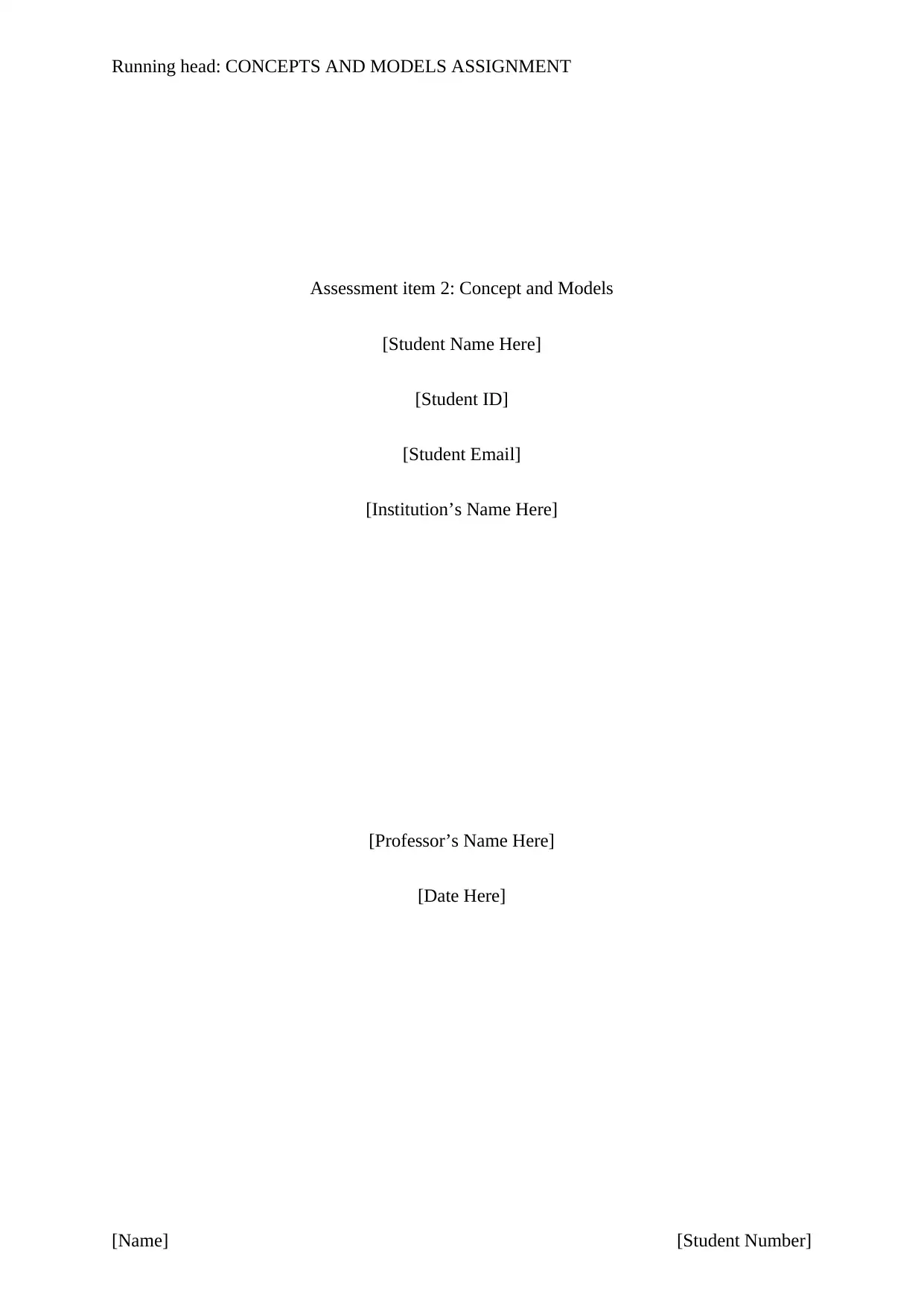
Running head: CONCEPTS AND MODELS ASSIGNMENT
Assessment item 2: Concept and Models
[Student Name Here]
[Student ID]
[Student Email]
[Institution’s Name Here]
[Professor’s Name Here]
[Date Here]
[Name] [Student Number]
Assessment item 2: Concept and Models
[Student Name Here]
[Student ID]
[Student Email]
[Institution’s Name Here]
[Professor’s Name Here]
[Date Here]
[Name] [Student Number]
Paraphrase This Document
Need a fresh take? Get an instant paraphrase of this document with our AI Paraphraser
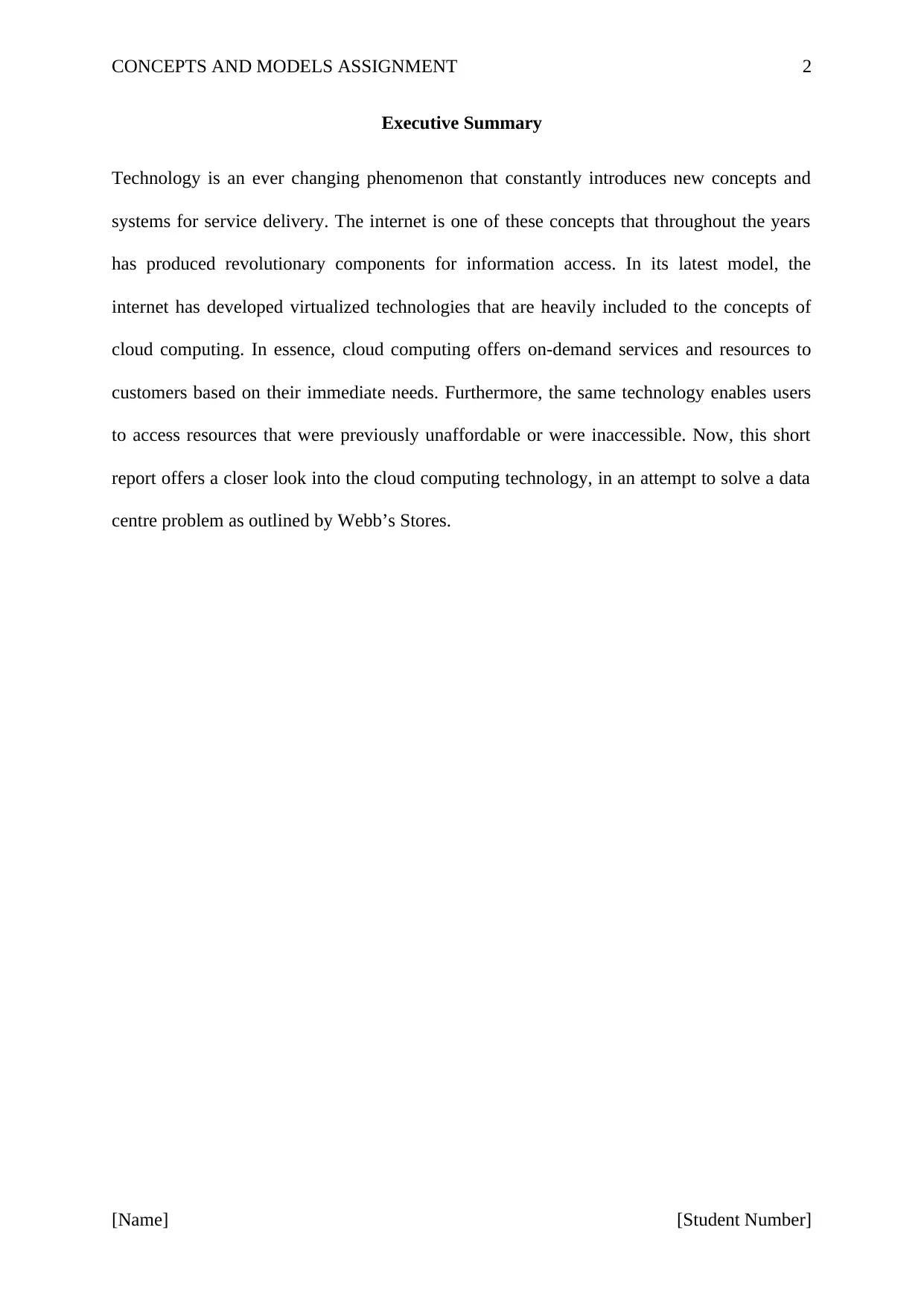
CONCEPTS AND MODELS ASSIGNMENT 2
Executive Summary
Technology is an ever changing phenomenon that constantly introduces new concepts and
systems for service delivery. The internet is one of these concepts that throughout the years
has produced revolutionary components for information access. In its latest model, the
internet has developed virtualized technologies that are heavily included to the concepts of
cloud computing. In essence, cloud computing offers on-demand services and resources to
customers based on their immediate needs. Furthermore, the same technology enables users
to access resources that were previously unaffordable or were inaccessible. Now, this short
report offers a closer look into the cloud computing technology, in an attempt to solve a data
centre problem as outlined by Webb’s Stores.
[Name] [Student Number]
Executive Summary
Technology is an ever changing phenomenon that constantly introduces new concepts and
systems for service delivery. The internet is one of these concepts that throughout the years
has produced revolutionary components for information access. In its latest model, the
internet has developed virtualized technologies that are heavily included to the concepts of
cloud computing. In essence, cloud computing offers on-demand services and resources to
customers based on their immediate needs. Furthermore, the same technology enables users
to access resources that were previously unaffordable or were inaccessible. Now, this short
report offers a closer look into the cloud computing technology, in an attempt to solve a data
centre problem as outlined by Webb’s Stores.
[Name] [Student Number]
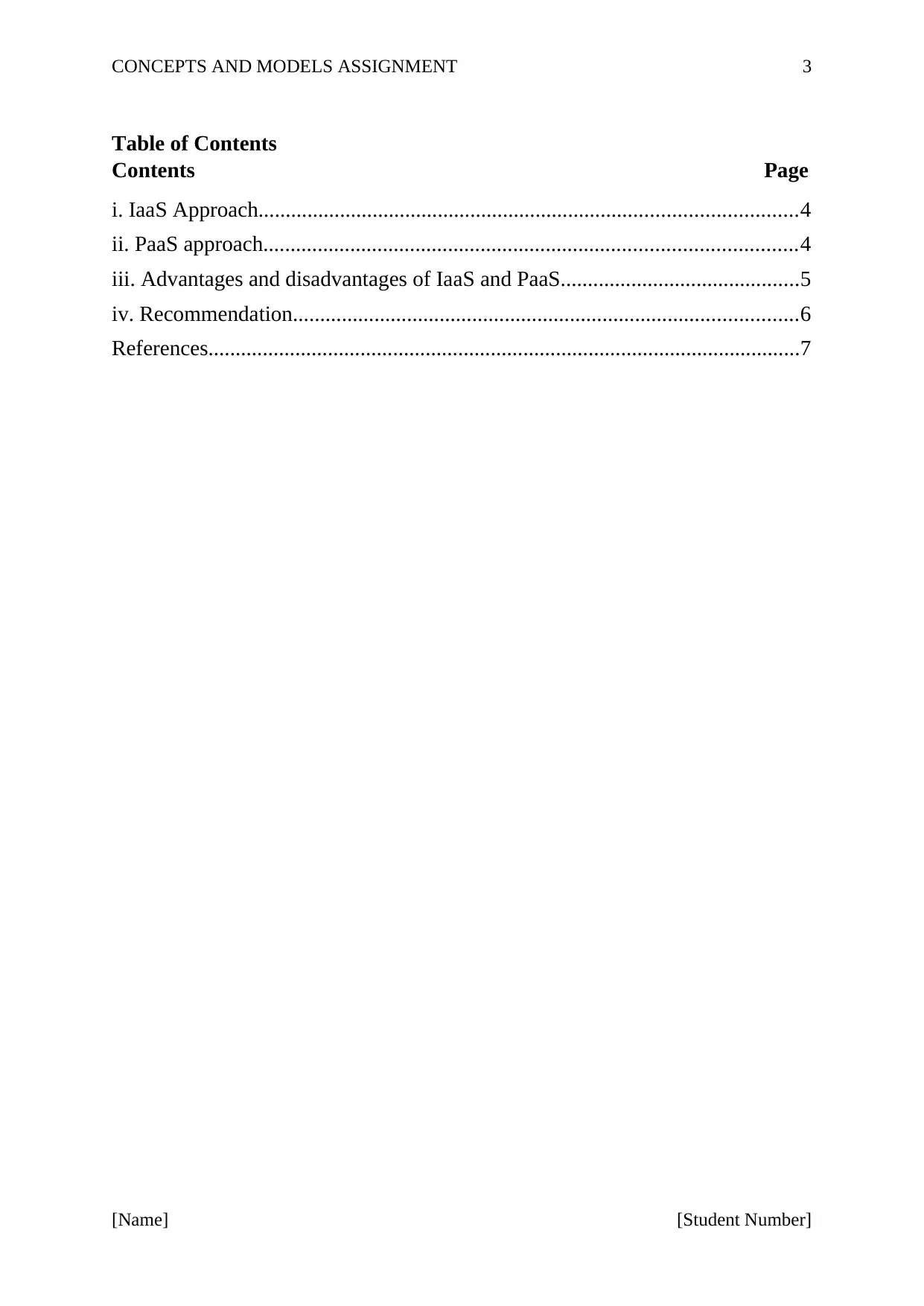
CONCEPTS AND MODELS ASSIGNMENT 3
Table of Contents
Contents Page
i. IaaS Approach...................................................................................................4
ii. PaaS approach..................................................................................................4
iii. Advantages and disadvantages of IaaS and PaaS............................................5
iv. Recommendation.............................................................................................6
References.............................................................................................................7
[Name] [Student Number]
Table of Contents
Contents Page
i. IaaS Approach...................................................................................................4
ii. PaaS approach..................................................................................................4
iii. Advantages and disadvantages of IaaS and PaaS............................................5
iv. Recommendation.............................................................................................6
References.............................................................................................................7
[Name] [Student Number]
⊘ This is a preview!⊘
Do you want full access?
Subscribe today to unlock all pages.

Trusted by 1+ million students worldwide
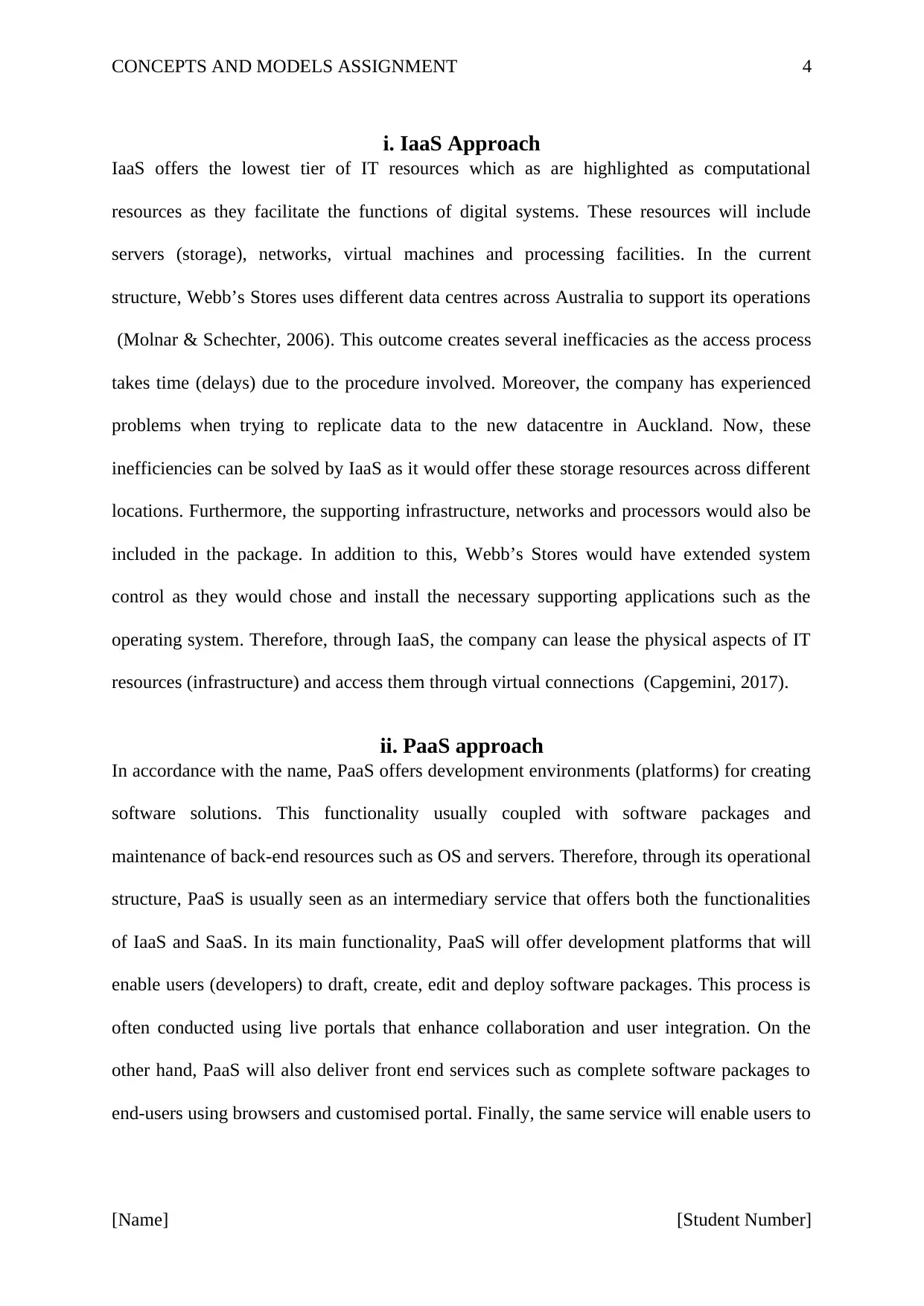
CONCEPTS AND MODELS ASSIGNMENT 4
i. IaaS Approach
IaaS offers the lowest tier of IT resources which as are highlighted as computational
resources as they facilitate the functions of digital systems. These resources will include
servers (storage), networks, virtual machines and processing facilities. In the current
structure, Webb’s Stores uses different data centres across Australia to support its operations
(Molnar & Schechter, 2006). This outcome creates several inefficacies as the access process
takes time (delays) due to the procedure involved. Moreover, the company has experienced
problems when trying to replicate data to the new datacentre in Auckland. Now, these
inefficiencies can be solved by IaaS as it would offer these storage resources across different
locations. Furthermore, the supporting infrastructure, networks and processors would also be
included in the package. In addition to this, Webb’s Stores would have extended system
control as they would chose and install the necessary supporting applications such as the
operating system. Therefore, through IaaS, the company can lease the physical aspects of IT
resources (infrastructure) and access them through virtual connections (Capgemini, 2017).
ii. PaaS approach
In accordance with the name, PaaS offers development environments (platforms) for creating
software solutions. This functionality usually coupled with software packages and
maintenance of back-end resources such as OS and servers. Therefore, through its operational
structure, PaaS is usually seen as an intermediary service that offers both the functionalities
of IaaS and SaaS. In its main functionality, PaaS will offer development platforms that will
enable users (developers) to draft, create, edit and deploy software packages. This process is
often conducted using live portals that enhance collaboration and user integration. On the
other hand, PaaS will also deliver front end services such as complete software packages to
end-users using browsers and customised portal. Finally, the same service will enable users to
[Name] [Student Number]
i. IaaS Approach
IaaS offers the lowest tier of IT resources which as are highlighted as computational
resources as they facilitate the functions of digital systems. These resources will include
servers (storage), networks, virtual machines and processing facilities. In the current
structure, Webb’s Stores uses different data centres across Australia to support its operations
(Molnar & Schechter, 2006). This outcome creates several inefficacies as the access process
takes time (delays) due to the procedure involved. Moreover, the company has experienced
problems when trying to replicate data to the new datacentre in Auckland. Now, these
inefficiencies can be solved by IaaS as it would offer these storage resources across different
locations. Furthermore, the supporting infrastructure, networks and processors would also be
included in the package. In addition to this, Webb’s Stores would have extended system
control as they would chose and install the necessary supporting applications such as the
operating system. Therefore, through IaaS, the company can lease the physical aspects of IT
resources (infrastructure) and access them through virtual connections (Capgemini, 2017).
ii. PaaS approach
In accordance with the name, PaaS offers development environments (platforms) for creating
software solutions. This functionality usually coupled with software packages and
maintenance of back-end resources such as OS and servers. Therefore, through its operational
structure, PaaS is usually seen as an intermediary service that offers both the functionalities
of IaaS and SaaS. In its main functionality, PaaS will offer development platforms that will
enable users (developers) to draft, create, edit and deploy software packages. This process is
often conducted using live portals that enhance collaboration and user integration. On the
other hand, PaaS will also deliver front end services such as complete software packages to
end-users using browsers and customised portal. Finally, the same service will enable users to
[Name] [Student Number]
Paraphrase This Document
Need a fresh take? Get an instant paraphrase of this document with our AI Paraphraser
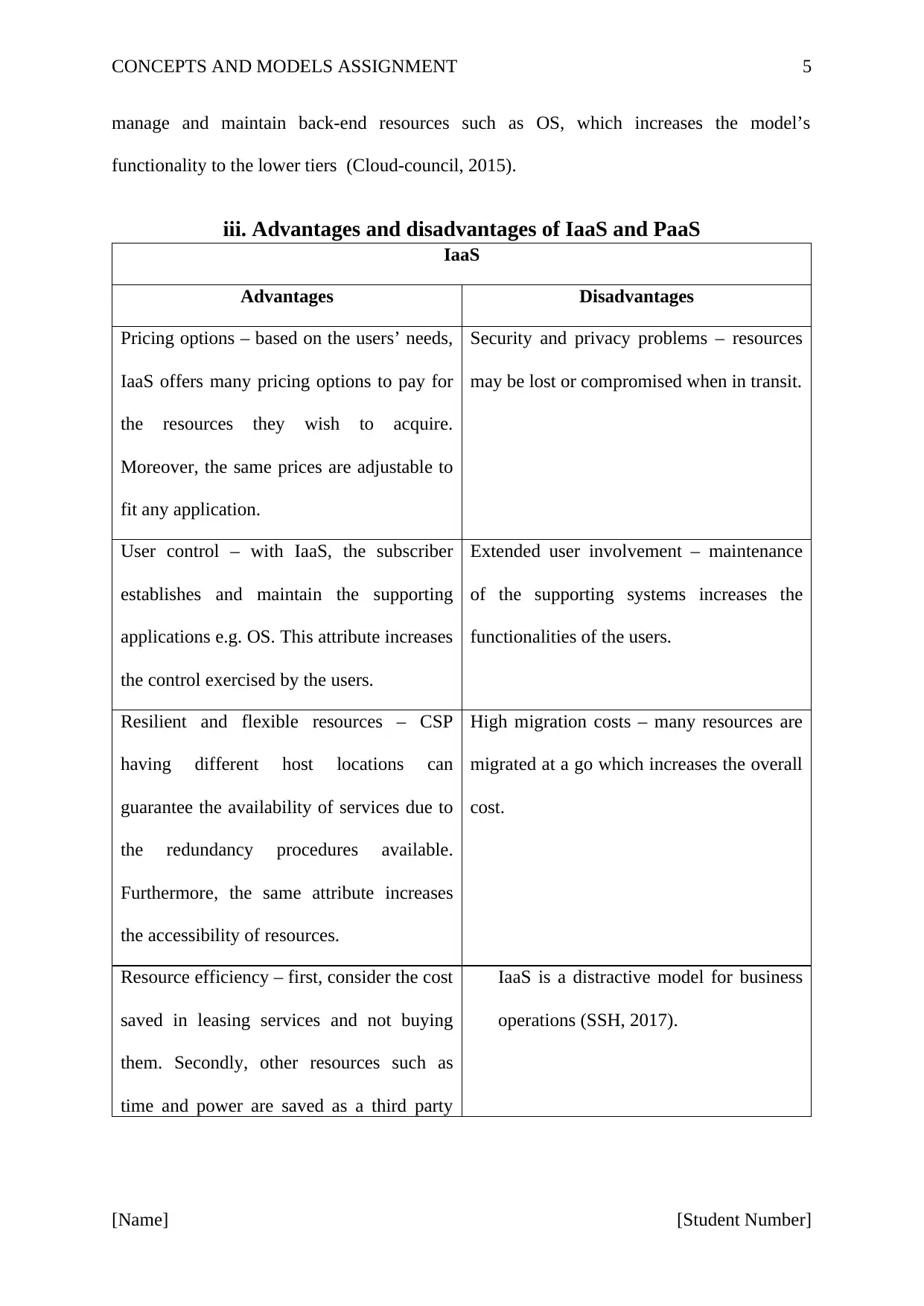
CONCEPTS AND MODELS ASSIGNMENT 5
manage and maintain back-end resources such as OS, which increases the model’s
functionality to the lower tiers (Cloud-council, 2015).
iii. Advantages and disadvantages of IaaS and PaaS
IaaS
Advantages Disadvantages
Pricing options – based on the users’ needs,
IaaS offers many pricing options to pay for
the resources they wish to acquire.
Moreover, the same prices are adjustable to
fit any application.
Security and privacy problems – resources
may be lost or compromised when in transit.
User control – with IaaS, the subscriber
establishes and maintain the supporting
applications e.g. OS. This attribute increases
the control exercised by the users.
Extended user involvement – maintenance
of the supporting systems increases the
functionalities of the users.
Resilient and flexible resources – CSP
having different host locations can
guarantee the availability of services due to
the redundancy procedures available.
Furthermore, the same attribute increases
the accessibility of resources.
High migration costs – many resources are
migrated at a go which increases the overall
cost.
Resource efficiency – first, consider the cost
saved in leasing services and not buying
them. Secondly, other resources such as
time and power are saved as a third party
IaaS is a distractive model for business
operations (SSH, 2017).
[Name] [Student Number]
manage and maintain back-end resources such as OS, which increases the model’s
functionality to the lower tiers (Cloud-council, 2015).
iii. Advantages and disadvantages of IaaS and PaaS
IaaS
Advantages Disadvantages
Pricing options – based on the users’ needs,
IaaS offers many pricing options to pay for
the resources they wish to acquire.
Moreover, the same prices are adjustable to
fit any application.
Security and privacy problems – resources
may be lost or compromised when in transit.
User control – with IaaS, the subscriber
establishes and maintain the supporting
applications e.g. OS. This attribute increases
the control exercised by the users.
Extended user involvement – maintenance
of the supporting systems increases the
functionalities of the users.
Resilient and flexible resources – CSP
having different host locations can
guarantee the availability of services due to
the redundancy procedures available.
Furthermore, the same attribute increases
the accessibility of resources.
High migration costs – many resources are
migrated at a go which increases the overall
cost.
Resource efficiency – first, consider the cost
saved in leasing services and not buying
them. Secondly, other resources such as
time and power are saved as a third party
IaaS is a distractive model for business
operations (SSH, 2017).
[Name] [Student Number]
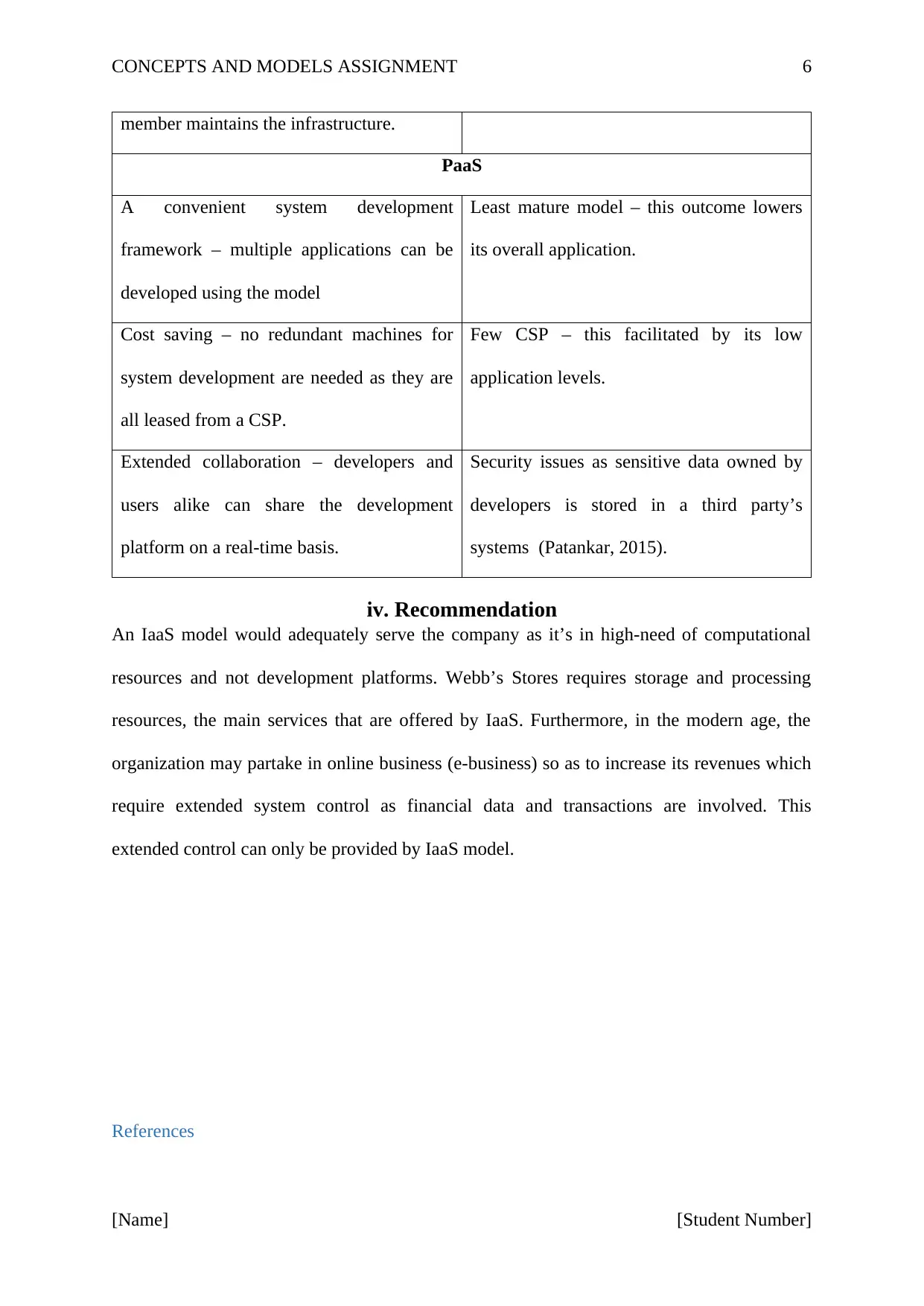
CONCEPTS AND MODELS ASSIGNMENT 6
member maintains the infrastructure.
PaaS
A convenient system development
framework – multiple applications can be
developed using the model
Least mature model – this outcome lowers
its overall application.
Cost saving – no redundant machines for
system development are needed as they are
all leased from a CSP.
Few CSP – this facilitated by its low
application levels.
Extended collaboration – developers and
users alike can share the development
platform on a real-time basis.
Security issues as sensitive data owned by
developers is stored in a third party’s
systems (Patankar, 2015).
iv. Recommendation
An IaaS model would adequately serve the company as it’s in high-need of computational
resources and not development platforms. Webb’s Stores requires storage and processing
resources, the main services that are offered by IaaS. Furthermore, in the modern age, the
organization may partake in online business (e-business) so as to increase its revenues which
require extended system control as financial data and transactions are involved. This
extended control can only be provided by IaaS model.
References
[Name] [Student Number]
member maintains the infrastructure.
PaaS
A convenient system development
framework – multiple applications can be
developed using the model
Least mature model – this outcome lowers
its overall application.
Cost saving – no redundant machines for
system development are needed as they are
all leased from a CSP.
Few CSP – this facilitated by its low
application levels.
Extended collaboration – developers and
users alike can share the development
platform on a real-time basis.
Security issues as sensitive data owned by
developers is stored in a third party’s
systems (Patankar, 2015).
iv. Recommendation
An IaaS model would adequately serve the company as it’s in high-need of computational
resources and not development platforms. Webb’s Stores requires storage and processing
resources, the main services that are offered by IaaS. Furthermore, in the modern age, the
organization may partake in online business (e-business) so as to increase its revenues which
require extended system control as financial data and transactions are involved. This
extended control can only be provided by IaaS model.
References
[Name] [Student Number]
⊘ This is a preview!⊘
Do you want full access?
Subscribe today to unlock all pages.

Trusted by 1+ million students worldwide
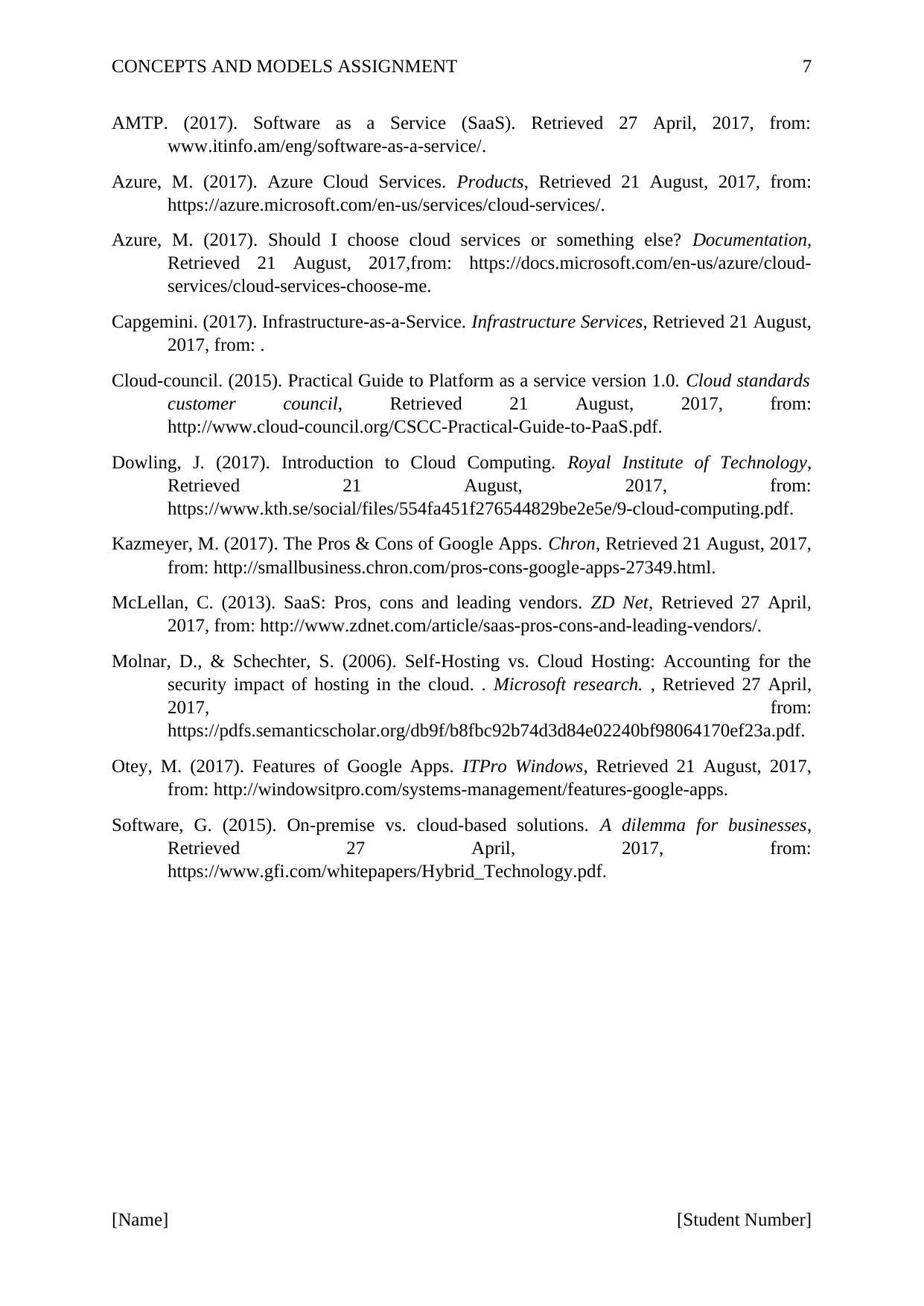
CONCEPTS AND MODELS ASSIGNMENT 7
AMTP. (2017). Software as a Service (SaaS). Retrieved 27 April, 2017, from:
www.itinfo.am/eng/software-as-a-service/.
Azure, M. (2017). Azure Cloud Services. Products, Retrieved 21 August, 2017, from:
https://azure.microsoft.com/en-us/services/cloud-services/.
Azure, M. (2017). Should I choose cloud services or something else? Documentation,
Retrieved 21 August, 2017,from: https://docs.microsoft.com/en-us/azure/cloud-
services/cloud-services-choose-me.
Capgemini. (2017). Infrastructure-as-a-Service. Infrastructure Services, Retrieved 21 August,
2017, from: .
Cloud-council. (2015). Practical Guide to Platform as a service version 1.0. Cloud standards
customer council, Retrieved 21 August, 2017, from:
http://www.cloud-council.org/CSCC-Practical-Guide-to-PaaS.pdf.
Dowling, J. (2017). Introduction to Cloud Computing. Royal Institute of Technology,
Retrieved 21 August, 2017, from:
https://www.kth.se/social/files/554fa451f276544829be2e5e/9-cloud-computing.pdf.
Kazmeyer, M. (2017). The Pros & Cons of Google Apps. Chron, Retrieved 21 August, 2017,
from: http://smallbusiness.chron.com/pros-cons-google-apps-27349.html.
McLellan, C. (2013). SaaS: Pros, cons and leading vendors. ZD Net, Retrieved 27 April,
2017, from: http://www.zdnet.com/article/saas-pros-cons-and-leading-vendors/.
Molnar, D., & Schechter, S. (2006). Self-Hosting vs. Cloud Hosting: Accounting for the
security impact of hosting in the cloud. . Microsoft research. , Retrieved 27 April,
2017, from:
https://pdfs.semanticscholar.org/db9f/b8fbc92b74d3d84e02240bf98064170ef23a.pdf.
Otey, M. (2017). Features of Google Apps. ITPro Windows, Retrieved 21 August, 2017,
from: http://windowsitpro.com/systems-management/features-google-apps.
Software, G. (2015). On-premise vs. cloud-based solutions. A dilemma for businesses,
Retrieved 27 April, 2017, from:
https://www.gfi.com/whitepapers/Hybrid_Technology.pdf.
[Name] [Student Number]
AMTP. (2017). Software as a Service (SaaS). Retrieved 27 April, 2017, from:
www.itinfo.am/eng/software-as-a-service/.
Azure, M. (2017). Azure Cloud Services. Products, Retrieved 21 August, 2017, from:
https://azure.microsoft.com/en-us/services/cloud-services/.
Azure, M. (2017). Should I choose cloud services or something else? Documentation,
Retrieved 21 August, 2017,from: https://docs.microsoft.com/en-us/azure/cloud-
services/cloud-services-choose-me.
Capgemini. (2017). Infrastructure-as-a-Service. Infrastructure Services, Retrieved 21 August,
2017, from: .
Cloud-council. (2015). Practical Guide to Platform as a service version 1.0. Cloud standards
customer council, Retrieved 21 August, 2017, from:
http://www.cloud-council.org/CSCC-Practical-Guide-to-PaaS.pdf.
Dowling, J. (2017). Introduction to Cloud Computing. Royal Institute of Technology,
Retrieved 21 August, 2017, from:
https://www.kth.se/social/files/554fa451f276544829be2e5e/9-cloud-computing.pdf.
Kazmeyer, M. (2017). The Pros & Cons of Google Apps. Chron, Retrieved 21 August, 2017,
from: http://smallbusiness.chron.com/pros-cons-google-apps-27349.html.
McLellan, C. (2013). SaaS: Pros, cons and leading vendors. ZD Net, Retrieved 27 April,
2017, from: http://www.zdnet.com/article/saas-pros-cons-and-leading-vendors/.
Molnar, D., & Schechter, S. (2006). Self-Hosting vs. Cloud Hosting: Accounting for the
security impact of hosting in the cloud. . Microsoft research. , Retrieved 27 April,
2017, from:
https://pdfs.semanticscholar.org/db9f/b8fbc92b74d3d84e02240bf98064170ef23a.pdf.
Otey, M. (2017). Features of Google Apps. ITPro Windows, Retrieved 21 August, 2017,
from: http://windowsitpro.com/systems-management/features-google-apps.
Software, G. (2015). On-premise vs. cloud-based solutions. A dilemma for businesses,
Retrieved 27 April, 2017, from:
https://www.gfi.com/whitepapers/Hybrid_Technology.pdf.
[Name] [Student Number]
1 out of 7
Related Documents
Your All-in-One AI-Powered Toolkit for Academic Success.
+13062052269
info@desklib.com
Available 24*7 on WhatsApp / Email
![[object Object]](/_next/static/media/star-bottom.7253800d.svg)
Unlock your academic potential
Copyright © 2020–2025 A2Z Services. All Rights Reserved. Developed and managed by ZUCOL.





